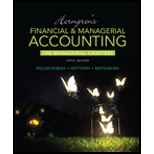
Concept explainers
Howard Company operates a chain of sandwich shops. The company is considering two possible expansion plans. Plan A would open eight smaller shops at a cost of $8,500,000. Expected annual net
Requirements
- 1. Compute the payback, the ARR, the
NPV , and the profitability index of these two plans. - 2. What are the strengths and weaknesses of these capital budgeting methods?
- 3. Which expansion plan should Howard Company choose? Why?
- 4. Estimate Plan A’s
IRR . How does the IRR compare with the company’s requiredrate of return ?
Want to see the full answer?
Check out a sample textbook solution
Chapter 26 Solutions
Horngren's Financial & Managerial Accounting, The Managerial Chapters (6th Edition)
Additional Business Textbook Solutions
Intermediate Accounting (2nd Edition)
Fundamentals of Management (10th Edition)
Principles of Microeconomics (MindTap Course List)
Economics of Money, Banking and Financial Markets, The, Business School Edition (5th Edition) (What's New in Economics)
Foundations Of Finance
Horngren's Accounting (12th Edition)
- On July 10, Queer Optics sells merchandise on account to Vision Plus (VP) for $5,200, terms 3/10, n/30. On July 14, VP returns merchandise worth $1,200 to Queer Optics. On July 18, VP completely fulfills its obligation to Queer Optics by making a cash payment. What is the amount of cash paid by VP to Queer Optics?arrow_forwardA company reports total liabilities of $2,100 and stockholders' equity of $1,600. What is the amount of total assets?arrow_forwardhi expert please help mearrow_forward
 Managerial Accounting: The Cornerstone of Busines...AccountingISBN:9781337115773Author:Maryanne M. Mowen, Don R. Hansen, Dan L. HeitgerPublisher:Cengage Learning
Managerial Accounting: The Cornerstone of Busines...AccountingISBN:9781337115773Author:Maryanne M. Mowen, Don R. Hansen, Dan L. HeitgerPublisher:Cengage Learning EBK CONTEMPORARY FINANCIAL MANAGEMENTFinanceISBN:9781337514835Author:MOYERPublisher:CENGAGE LEARNING - CONSIGNMENTPrinciples of Accounting Volume 2AccountingISBN:9781947172609Author:OpenStaxPublisher:OpenStax College
EBK CONTEMPORARY FINANCIAL MANAGEMENTFinanceISBN:9781337514835Author:MOYERPublisher:CENGAGE LEARNING - CONSIGNMENTPrinciples of Accounting Volume 2AccountingISBN:9781947172609Author:OpenStaxPublisher:OpenStax College Cornerstones of Cost Management (Cornerstones Ser...AccountingISBN:9781305970663Author:Don R. Hansen, Maryanne M. MowenPublisher:Cengage Learning
Cornerstones of Cost Management (Cornerstones Ser...AccountingISBN:9781305970663Author:Don R. Hansen, Maryanne M. MowenPublisher:Cengage Learning




